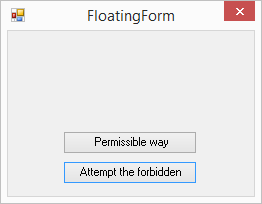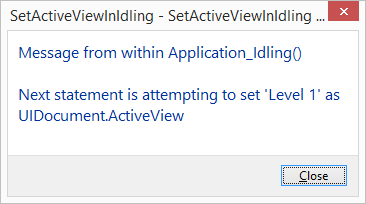Setting Active View During Idling
Here is a summary of the discussion and solution
for setting ActiveView during the Idling event from
the Revit API discussion forum raised
and solved by Rudi 'Revitalizer' and Kinjal Desai, founder and fullstack developer
at Dwaravati:
Question: I need to set ActiveView in Idling event handler.
As per API documentation, this operation should not be invalid: no open transactions; IsModifiable is ok; IsReadOnly is ok; No pre-action events around.
However, trying to do so throws an InvalidOperationException with the message "Setting active view is temporarily disabled".
Closest explanation I could reach to is Jeremy's casual reply "the system may be busy with something else" to a blog comment on activating a 3D View.
In a sense, that is the case – the system is 'busy', because the Idling event is being processed at the moment.
However, I wonder if that is the real reason or a real limitation in this case – for the system is also busy when IExternalCommand.Execute is being processed, in which case setting ActiveView functions perfectly.
Looking forward to expert comments on whether setting ActiveView is indeed invalid in Idling under all circumstances and whether there is a way around it.
Answer 1: As a workaround, would it be possible to select the view (using the API), then use PostCommand to set the active view? Then wait for idling again...
Answer 2: There is a UIDocument.RequestViewChange method made for the case you described.
It is included in the Revit 2015 API
Document API additions:
UIDocument Operations and Additions
The new method UIDocument.RequestViewChange requests to change the active view by posting a message asynchronously. Unlike setting the ActiveView property, this will not make the change in active view immediately. Instead, the request will be posted to occur when control returns to Revit from the API context. This method is permitted to change the active view from the Idling event or an ExternalEvent callback.
Response: Thank you for all your suggestions and for bringing this to light.
It is async, but that's clearly the author's intended way; I'll fit my logic around it.
Imho, the API reference would be more useful (and save some hours and brain tissues) if such 'sister' functions could be linked in 'See Also' or something.
I implemented the suggestion using RequestViewChange.
Using a async call wasn't ideal for my specific need, but I refactored my code to accommodate it.
In absence of any answers, my fall-back alternative (far from ideal, but functional nonetheless), would have been to fire Ctrl+F4 keystrokes (conditionally) from the Idling event. I am not fan of this approach, but it would also have served for my specific use case.
RequestViewChange is definitively the API authors' intended way to achieve this.
I attached a sample model containing macros to demonstrate both the problem and the solution implementing the permissible and intended way to change active view from Idling.
It is a project file with a blank model with two floor plans, containing the code (fairly simple and self-explanatory) in document macros.
On launching the Demo_SetActiveViewInIdling macro, a modeless form is displayed:

If you choose the permissible working solution, a message is displayed announcing what will happen, and the action is successfully performed:

If you attempt the problematic approach, this is also announced in advance:

The problematic approach throws an exception, which is handled and reported as well:

The macro mainline just launches the modeless form that does all the work:
public void Demo_SetActiveViewInIdling() { FloatingForm form = new FloatingForm(); form.Setup( Application ); form.Show(); }
Here is the actual working code implemented by FloatingForm:
namespace SetActiveViewInIdling { /// <summary> /// Description of FloatingForm. /// </summary> public partial class FloatingForm : WinForm.Form { bool attemptSettingActiveView_forbidden; bool attemptSettingActiveView_async; bool deregister; #region Operational & misc public FloatingForm() { // // The InitializeComponent() call is required for Windows Forms designer support. // InitializeComponent(); this.FormClosing += FloatingForm_FormClosing; } private void FloatingForm_FormClosing( object sender, WinForm.FormClosingEventArgs e ) { deregister = true; } UIApplication uiApplication; internal void Setup( UIApplication uiApplication ) { this.uiApplication = uiApplication; this.uiApplication.Idling += Application_Idling; } #endregion private void demoButton_Click( object sender, EventArgs e ) { //this flag will be picked by next call to our Idling event handler attemptSettingActiveView_forbidden = true; } private void demoButton2_Click( object sender, EventArgs e ) { //this flag will be picked by next call to our Idling event handler attemptSettingActiveView_async = true; } private void Application_Idling( object sender, Autodesk.Revit.UI.Events.IdlingEventArgs e ) { if( attemptSettingActiveView_forbidden ) { try { attemptSettingActiveView_async = false; attemptSettingActiveView_forbidden = false; var arbitaryFloorPlan = new FilteredElementCollector( uiApplication.ActiveUIDocument.Document ).OfClass( typeof( ViewPlan ) ).Cast<ViewPlan>().Where( x => !x.IsTemplate ).FirstOrDefault(); if( arbitaryFloorPlan != null ) { TaskDialog.Show( "SetActiveViewInIdling sample", "Message from within Application_Idling()\n\nNext statement is attempting to set \'" + arbitaryFloorPlan.ViewName + "\' as UIDocument.ActiveView" ); uiApplication.ActiveUIDocument.ActiveView = arbitaryFloorPlan; } else TaskDialog.Show( "SetActiveViewInIdling sample", "Add one or more Floor Plans." ); } catch( Autodesk.Revit.Exceptions.InvalidOperationException invalidOperationException ) { TaskDialog.Show( "SetActiveViewInIdling sample", "***Issue Reproduced***\n\nMessage: " + invalidOperationException.Message + "\n\nFor more details, attach debugger, breakopint at FloatingForm.Application_Idling > catch." ); } } else if( attemptSettingActiveView_async ) { attemptSettingActiveView_async = false; attemptSettingActiveView_forbidden = false; var arbitaryFloorPlan = new FilteredElementCollector( uiApplication.ActiveUIDocument.Document ).OfClass( typeof( ViewPlan ) ).Cast<ViewPlan>().Where( x => !x.IsTemplate ).FirstOrDefault(); TaskDialog.Show( "SetActiveViewInIdling sample", "Message from within Application_Idling()\n\nNext statement will request \'" + arbitaryFloorPlan.ViewName + "\' to be activated (using UIDocument.RequestViewChange()) asynchronously." ); uiApplication.ActiveUIDocument.RequestViewChange( arbitaryFloorPlan ); } else if( deregister ) { this.uiApplication.Idling -= Application_Idling; } } } }
Many thanks to Kinjal for implementing and sharing this nice demo solution, and to Matt Taylor and above all Rudi 'Revitalizer' for their good suggestions!